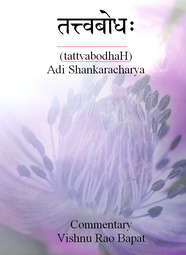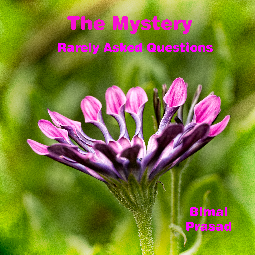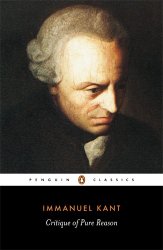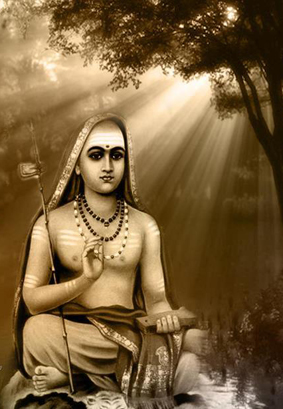
VEDĀNTA the solution to our fundamental problem by D. Venugopal
Part 33 explains the nature of mAyA and its relation to brahman and avidyA.
There is a complete Contents List, to which links are added as each new part appears.


VEDĀNTA the solution to our fundamental problem by D. Venugopal
Part 33 explains the nature of mAyA and its relation to brahman and avidyA.
There is a complete Contents List, to which links are added as each new part appears.

VEDĀNTA the solution to our fundamental problem by D. Venugopal
Part 32 concludes the ‘definition’ of brahman and then begins to look at brahman as the cause of the manifestation.
There is a complete Contents List, to which links are added as each new part appears.

Part 17 of the commentary by Dr. VIshnu Bapat on Shankara’s Tattvabodha.This is a key work which introduces all of the key concepts of Advaita in a systematic manner.
The commentary is based upon those by several other authors, together with the audio lectures of Swami Paramarthananda. It includes word-by-word breakdown of the Sanskrit shloka-s so should be of interest to everyone, from complete beginners to advanced students.
Part 17 begins the analysis of creation. The nature of mAyA is explained and the description of the five basic elements is begun.
There is a hyperlinked Contents List, which is updated as each new part is published.
| Claim against Swamiji (SSS) |
| Big fuss on whether avidya =mAyA |
| · Swamiji does not like tarka or reasoning |
| · Swamiji does not admit of avidyA in deep sleep |
| · Swamiji does not endorse prakarana works, as he says they are not written by Shankara |
| · Swamiji claims no role for bhakti in the advaita tradition |
| · Swamiji does not accept that an enlightened soul may still suffer the consequences of past deeds |
| · Swamiji advocates learning from books only, and being self taught without a teacher |
| · Swamiji overuses the phrase adhyAropa-apavAda giving the impression it his discovery |
| · Swamiji is not of the tradition |
| · Swamiji claims he is right and everyone else is wrong |

Continuing this new, short series presenting the booklet by Bimal Prasad, in which he answers some ‘Rarely Asked Questions’ on Life. Primarily from the perspective of Advaita, questions addressed include the nature of happiness, consciousness, mind and ego. There is also practical guidance on meditation in the final chapter. Answers are relevant and succinct, so that many of the issues of interest to the seeker are covered.
This sixth part looks at the relationship between Consciousness, witness and ego, at the nature of the Self and reality, and asks what we mean by Self-knowledge. See the Contents List or go straight to Part 6 of the series.
The complete (electronic form) booklet may also be purchased from Amazon.
This the first of a three-part series discussing the relevance of Kant’s philosophy to Advaita. 
Immanuel Kant published the first edition of The Critique of Pure Reason in 1781, with an extensively rewritten second edition appearing in 1787. Between those editions he also published a shorter “easier” introduction to his philosophy, Prolegomena to Any Future Metaphysics (1783). With the later appearance of The Critique of Practical Reason (1788) and The Critique of Judgement (1790), Kant had articulated a complete system of philosophy of incredible depth and complexity, wholly original and unique in its solution to the age-old problems of reason, ethics, and logic. So great was the importance of this Prussian professor, we may justifiably think in terms of pre-Kantian and post-Kantian philosophy. Many have disagreed with his conclusions and offered refutations on one level or another, but all who have come after Kant have been required to address him. Continue reading
 There has been much healthy debate recently on the Advaita Vision Blog about Liberation, who or what is a jnani or jivanmukta, and what it means to follow traditional Advaita. The theme of this post is that we cannot resolve such questions without first gaining a clear understanding of the body-mind and its role in the context of Liberation. What follows are some reflections inspired by a spirited discussion with Ramesam, with due credit to him for stimulating many of the thoughts below. Any errors or possible misunderstandings are entirely my fault. Or perhaps not, since “Words fall back from it.” Continue reading
There has been much healthy debate recently on the Advaita Vision Blog about Liberation, who or what is a jnani or jivanmukta, and what it means to follow traditional Advaita. The theme of this post is that we cannot resolve such questions without first gaining a clear understanding of the body-mind and its role in the context of Liberation. What follows are some reflections inspired by a spirited discussion with Ramesam, with due credit to him for stimulating many of the thoughts below. Any errors or possible misunderstandings are entirely my fault. Or perhaps not, since “Words fall back from it.” Continue reading
Here is a question and answer from several years ago, which addresses a topic that I avoided getting involved with publically at the time.
Q: I recently bought a book called “Final Truth” by Ramesh Balsekar. I read the book and now see it as one of the most “deep” and “philosophical” books on Advaita. But then I read Balsekar had some sex scandals and preached “do whatever you want you are not responsible” philosophy and I`m shocked. Anyway…
I saw an idea in the book and it resonated with me so much. In my opinion, It even explains (for some level) why there is Maya or why the appearances exists or why there is “creation” in the first place. (or Why there seems to be creation) The idea is this: The formless Consciousness can be experienced only through the multitude of sentient bodies with names and forms, just as light can be seen only through refracting agents. It is thus not that the multitude of names and forms exist independently of Consciousness but that Consciousness can express itself only through these forms.
So the other way of saying is the God or the Brahman or the Consciousness experiences himself through us. We and the universe are God looking into himself.
Brihadarnyaka 2.5.19 has this verse
“He transformed Himself in accordance with each form; that form of His was for the sake of making Him known. The Lord on account of Maya (notions superimposed by ignorance) is perceived as manifold, for to Him are yoked ten organs, nay, hundreds of them. He is the organs; He is ten and thousands – many and infinite. That Brahman is without prior or posterior, without interior or exterior. This self, the perceiver of everything, is Brahman. This is the teaching.”
What do you think? I wanted to know if traditional Advaita accepts that idea or not.
A: As it seems with most questions I get these days, this one also revolves around the reality-appearance, paramArtha-vyavahAra question.
Who-you-really-are does not act, so cannot be ‘responsible’ in the sense that you mean here. The person, on the other hand, does act and is responsible, and gets puNya-papa as a result of those actions. It is especially the responsibility of the realized person to act in accordance with dharma – the awareness of right and wrong – since he is setting an example to others. However it is also possible that, because of insufficient prior mental preparation, an enlightened person is still attached to desires and fears. Even knowing that he is perfect and unlimited, he could still act in accordance with these feelings, which are called pratibandha-s (obstacles or impediments). These will go in time, with further nididhyAsana.
It has to be assumed that this was the position regarding Ramesh, as far as the ‘scandals’ are concerned. However, if it was the case that he was actually preaching “do whatever you want you are not responsible”, as you say, then this is not a clear presentation of the truth of the situation and should be condemned.
Regarding your second point about the ‘purpose’ for the seeming creation, this does not hold water either. There can be no meaningful attribution of purpose at all. Purpose implies some sort of deficiency in brahman, which is a contradiction. Experience of any sort is a limitation, so cannot be applied to brahman. Best just to think of everything as name and form, including the ignorance and the experience; the experienced and the experiencer. But, as an imaginative way of thinking about it, God looking into himself is fine, as long as you don’t take it literally.
Q: For the last few years I have been trying to develop a manuscript detailing a working model which marriages the teachings of Advaita Vedanta with contemporary research on NDE or “Near Death Experience” and similar fields of inquiry. There are several questions I have, but for now I will only bother you with one: Is it possible the Atman does possess a “spiritual ego”?
Clearly the culprit for the ignorance of our real self as the Self is the wrongful identification with the body-mind. Shankara explains the identification with the kosha-s perpetuates the illusion, which is nothing more than a superimposition of the kosha(s) on brahman helped by mAyA.
The way I see it, our greatest enemy is the ego, the human ego. This ego comes from the mind and is maintained alive by desires. But I have many reasons to suspect there is also a “spiritual ego” present in the Atman, which similarly perpetuates the ignorance of the wrongful identification by the so-called discarnate “spirit soul”.
The metaphor I have used is this: there is an actor in the “spiritual world” (the Atman) which wrongfully identifies with a spiritual ego preventing it from realizing brahman. This actor goes through an induced amnesia, after agreeing to play the role of a character in the Grand Stage of the world. This is the incarnation stage. The human ego is the combination of the spiritual ego – which carries the saMskAra-s and the vAsanA-s – plus particular influences on the personality traits caused by internal factors such as the brain/mind of the new body, as well as external factors such as family, society, education, etc. This is the embodied Atman as the jIva. Continue reading
Q: What is the relationship between memory and superimposition (adhyAsa)? In the metaphor of rope and snake, we say that we fail to see the snake clearly, because of inadequate light – there is partial knowledge and partial ignorance. When we superimpose a snake on the rope, we are drawing on fear and memory. We must have seen a snake (or image of one in a film or book) before in order to be able to mistake the rope for one. Similarly, we mistake brahman for the body and the world etc.
But what about a baby or someone who has no memory as a result of brain damage? Is there still superimposition in this case?
Responses from Ted, Venkat, Ramesam, Martin, Sitara and Dennis
A (Ted): We have to bear in mind that the example of a rope being mistaken for a snake is an analogy, and as is the case with any analogy, the example is imperfect. In the example, the snake image is based on a previous experience of the mistaken perceiver.
In terms of mistaking the body-mind-sense complex as well as the innumerable other objects that constitute the manifest universe for Brahman, however, we are dealing with something a little bit different. Whereas in order to mistake the rope for a snake, one must have previously seen a snake, the projection of the apparent reality (i.e., the manifest universe in both its subtle and gross aspects) is not based on experiential memory, but rather results from the mind’s ability to recognize the “cosmic blueprints” that abide in dormant form in the Macrocosmic Causal Body, which is personified as Isvara, and are made manifest through the conditioning that maya upadhi, the limiting adjunct of causal matter, puts upon Brahman. That is, the mind is an instrument that is designed or a mechanism that is “programmed” to recognize these forms and, thus, is able to discern their apparent existence within the cosmic soup of pure potentiality (i.e., the unmanifest realm or “mind of God,” if you will) from the data it receives via the perceptive instruments/organs. Continue reading